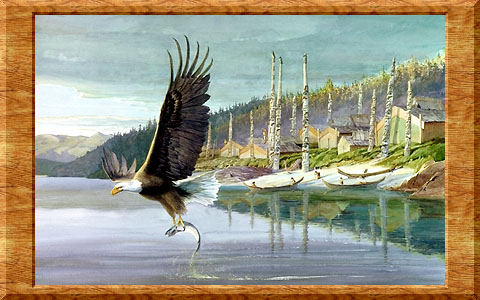
Original watercolour 22" x 29" by Gordon Miller © 1987
The national bird of the United States, the Bald Eagle (Haliaeetus leucocephalus) is only abundant on the Alaskan and British Columbia coasts. Our largest eagle, with wing spans up to eight feet, it is not as fierce as its appearance suggests. It feeds primarily on dead or dying fish, shell-fish and carcasses of dead animals. Eagles mate for life, and build large nests of sticks in high tree tops which they occupy and add to for years. Over time these nests can grow to weigh over a ton and be ten feet across.

Original watercolour 22" x 29" by Gordon Miller © 1987
All Haida claim membership in one of two groups, the Ravens or the Eagles. About three hundred years ago, one group of Eagles from the northern shores of the Queen Charlotte Islands migrated to the Prince of Wales Archipelago of southeastern Alaska. These Alaskan Haida were formerly known as Kaigani, after the name of their first village near the southern tip of Dall Island.
Old Kasaan, or "beautiful town", was situated on Skowl Arm, Prince of Wales Island. Chief Skowl was a firm defender of Native customs against Russian Orthodox missionaries during Russian rule. At the end of the nineteenth century, Kasaan had seventeen lodges and sixty of the finest poles in Alaska, and was a favourite stop for summer tourists during the Gay '90s. It was set aside as a U.S. National Monument in 1907, and so proclaimed in 1916. Deserted and neglected, in 1954 the U.S. Government abolished its status as a National Monument and left the old site to the encroaching forest.